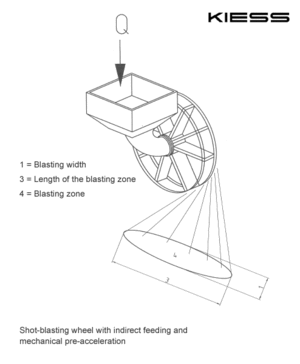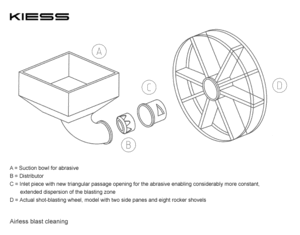2.1 Airless blast cleaning
During the process of airless blast cleaning the abrasive is introduced through the hub of the shot-blasting wheel into a turning rocker shovel and it is expelled within a widely spread blast to the surface of the workpiece to be treated at a high speed and thus also at a high peripheral speed. The accelerating energy is obtained by:
- the speed of the wheel
- the diameter and the width of the wheel.
The highest inflow of abrasive into the wheel is reached when using a wheel with only two shovels. Ejection efficiency, however, is very bad because there is a high degree of spreading.
As regards smaller shot-blasting wheels only 2 shovels are taken due to cost reasons, 4 shovels are taken for medium-sized wheels; and 6 or 8 shovels are used for those units having a big diameter.
Centrifuges are mainly used in steel industry, in foundries and in the field of steel and apparatus construction as well as in ship building. Those are mainly machines which can be rarely designed in such a way that they can be used universally for the treatment of work pieces of different kinds.
It is their task to remove scale, rolling skin and rust from materials made of iron and steel. They run in such a way that profiles, plates, but also quite ordinary structural components as well as pipes are moved past the shot-blasting wheels on a roller table and then they are hit by the leaving abrasive flow.
By applying air blast cleaning in mobile plants it is also possible to perform surface cleaning of concrete and asphalt areas as well as steel floors. The complete machine is moved over the surface by an adjustable transport feeding device. The abrasive impinging on the surface is sucked back with a vacuum airstream via a channel to a storage device being installed above the shot-blasting wheel; then it will be dedusted and fed again back to circulation.

Shot-blastin wheel with indirect feeding and mechanical
Click to enlarge

Airless blast cleaning
Click to enlarge



